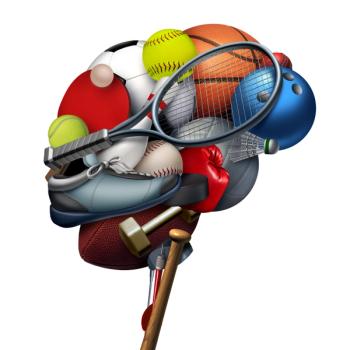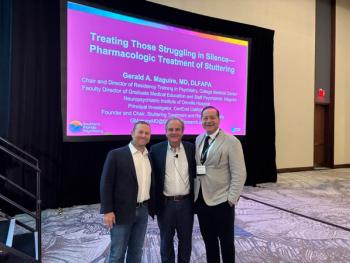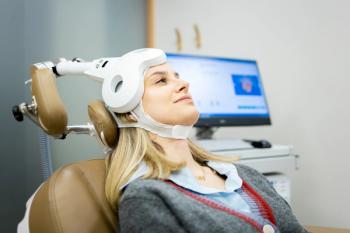
- Vol 40, Issue 2
The Status of Neuromodulation Trials in Eating Disorders
"20% to 30% of patients develop a persistent, hard-to-treat illness."
SPECIAL REPORT: EATING DISORDERS
The classical eating disorders (EDs),
Available first-line treatments (ie, mainly psychotherapies) are only moderately effective.1-3 It is estimated that 20% to 30% of patients develop a persistent, hard-to-treat illness. Little is known about how to sequence or combine treatments if first-line interventions are unsuccessful. Thus, novel interventions are needed.
Recent years have seen a “renaissance” of interest in neuromodulatory treatments of psychiatric disorders, driven by improved understanding of the neural substrates involved.4
Clinical trials focus mainly on reversible noninvasive interventions like repetitive transcranial magnetic stimulation (rTMS), most commonly in depression, with the dorsolateral prefrontal cortex (DLPFC) being a popular stimulation target for both theoretical and practical reasons.4,5
Neurobiological models of EDs propose that different EDs have distinct and overlapping neural signatures, including aberrant functioning in “bottom up” subcortical mesolimbic and reward-related regions and/or in “top down” prefrontal regions. Altered functioning of these neural systems is associated with impairments or inefficiencies in cognitive, reward, and emotional processes, and these may drive or maintain illness-related behaviors.6
Here we provide information about the clinical use of neuromodulation in EDs. We focus on modern noninvasive neurostimulation approaches, such as rTMS and transcranial direct current stimulation (tDCS) as well as invasive surgical methods like deep brain stimulation (DBS).
In TMS, a current is passed through an electromagnetic coil to induce an increase or decrease in cortical excitability in target brain regions. In tDCS, a constant weak direct current is applied via electrodes placed on the scalp to increase (anodal tDCS) or decrease (cathodal tDCS) cortical excitability. DBS involves surgical implantation of electrodes into key brain structures implicated in ED pathology. Evidence relating to these techniques in EDs is reviewed in this article.
TMS
For AN: Use of rTMS and its variants (eg, theta burst stimulation, insula H-coil) and different stimulation protocols or sites (eg, DLPFC, dorsomedial prefrontal cortex, insula) have been piloted in patients with AN in several case series and proof-of-concept studies.6-8
We completed the first (and, as yet, only) feasibility randomized controlled trial (RCT) of 20 sessions of real or sham high-frequency rTMS applied to the left DLPFC in 34 individuals with severe and enduring AN.9,10 Participants had an average illness duration of approximately 14 years, and all had received multiple previous treatments, including spending on average 10.5 months in the hospital for treatment of AN.
Approximately 60% were currently on an antidepressant. Thus, this was a highly treatment-refractory group. At the end of treatment (1-month postrandomization), there were few clinical differences between groups. However, on a food choice task, participants who received real rTMS showed an increase in the selection of tastier and more calorific foods posttreatment, relative to baseline.11 In parallel, arterial spin labeling data found greater reductions in amygdala cerebral blood flow following real rTMS compared with sham.12
By the end of the trial (4-months postrandomization follow-up), large between-group effect sizes in mood and medium-sized between-group effect sizes for quality of life had emerged, favoring real rTMS. However, there were only small between-group differences for body mass index (BMI), again favoring real rTMS. At this time point and prior to being unblinded, all participants had an in-depth qualitative interview inquiring about their experience. Those who had received real rTMS reported a growing flexibility and relaxation around eating and food choices, along with improvements in mood and an increasing ability to enjoy their lives.13
In an 18-month open follow-up of this trial, mood improvements remained broadly stable in the real rTMS group, and there was a “mood improvement catch-up” in the sham group, as most of these participants subsequently took the opportunity to receive real rTMS treatment.14
With regard to BMI score changes, by 18 months, there was a medium between-group effect, along with a higher rate of weight recovery in the original real rTMS group compared with sham (BMI > 18.5 kg/m2: 46% versus 9%).14 Importantly, greater reductions in amygdala cerebral blood flow posttreatment were associated with greater weight gain at 18 months.14 These findings suggest that rTMS led to (1) early neural changes in the amygdala that may have facilitated greater flexibility in food choices, and (2) improvements in mood that were durable and preceded changes in BMI.
For BN and BED: Two small RCTs used rTMS in BN; both had negative findings, possibly due to being underpowered and having a low treatment session number. However, a study of individuals with BN or AN (binge-purge subtype) that involved 20 to 30 sessions of rTMS (10 Hz) applied to the dorsomedial prefrontal cortex reported that the intervention resulted in increased frontostriatal connectivity that was associated with positive clinical responses.15
For BED, outcomes from a sham-controlled RCT of rTMS are awaited,6 but a recent review has concluded that rTMS has treatment potential for both BED and obesity.16
tDCS
For AN: Case series and nonrandomized studies of tDCS in AN have shown promise.6 In the only double-blind RCT, 43 inpatients with AN were randomized to receive 10 sessions of real or sham tDCS over the left DLPFC, with a final follow-up at 4 weeks posttreatment.17 There were no between-group differences on ED symptoms (the primary outcome measure) either at the end of treatment or at follow-up.17 As the trial was conducted in an inpatient setting, it is possible that a ceiling effect occurred.
However, secondary analysis revealed that active tDCS significantly improved self-evaluation based on body shape and decreased the need for excessive control over calorie intake at the 4-week follow-up.17 These results indicate parallels with findings from the only rTMS RCT in AN, in which a similar relaxation of self-regulatory control around food choices was identified.11
For BN and BED: Promising case series and proof-of-concept studies are available.6 Two currently unpublished RCTs from our group have used tDCS for BED combined with different types of cognitive training.18-20 These trainings, specifically approach or attention bias modification, are designed to teach individuals greater control over appetizing high-calorie food stimuli (eg, by learning not to approach them or directing attention away from them).
Such combination treatments are of interest because evidence suggests that the clinical efficacy of tDCS could be enhanced if it is applied during learning designed to promote symptom change (so-called functional targeting).5
Preliminary outcomes in both currently unpublished RCTs are encouraging, suggesting that combination treatments hold significant promise and deserve investigation in large-scale trials.
DBS
To date, only case reports and case series in patients with treatment- refractory AN have been conducted. Two systematic reviews have summarized the findings.21,22 One of these included 17 studies (n = 118 patients with AN; mean age, 30 years; mean illness duration, 16 years). In more than half of the patients, the subcallosal cingulate (SCC) was the stimulation target; in a third of patients, the nucleus accumbens (NAcc) was the target.
The AN cohort had an average BMI improvement of approximately 25% at a follow-up period of approximately 17 months. Complications included postoperative and poststimulative seizures, electrolyte disturbances, and infections (9%, 5%, and 1%, respectively).21
The second review performed a meta-analysis of DBS BMI outcomes across 4 nonrandomized studies involving 56 patients with AN. All were defined as treatment refractory (ie, had long-standing illness with multiple previous treatments). Thirty-two participants received DBS to the NAcc, 20 patients received DBS to the SCC, and 4 to the ventral anterior limb of the internal capsule (vALIC).
Meta-analysis showed improvements of a large effect size in BMI; mood, anxiety, and OCD symptoms; ED symptoms; general psychiatric symptoms; and quality of life at follow-up time points ranging from 6 to 24 months. Adverse effects related to stimulation procedures occurred in 9 cases (hypomanic symptoms, seizure, and autointoxication).22
To our knowledge, trials that include a sham phase has not yet been done with DBS in AN, and due to the invasiveness of the procedure, this is likely to require some thought in terms of ethics and design.
Gaps in Understanding
There are many uncertainties in our understanding of the pathophysiology of EDs and the mechanisms underpinning different neuromodulation approaches and their effects on different stimulation targets. In this context, the authors of the DBS meta-analysis22 pointed to evidence suggesting that DBS modulates widespread brain network activity (eg, normalizing neuronal firing in reward circuitry). While the trials included in the meta-analysis used diverse stimulation sites (including the NAcc, SCC, and vALIC), their effects were comparable.
The authors conclude firstly that “DBS may be effective at diverse targets, suggesting diverse inroads to [normalize] aberrant activity in comparable brain circuits” and secondly that “these effects may be shared with other psychiatric disorders, where similar targets resulted in transdiagnostic beneficial effects.”22
Of further note, across neuromodulation modalities, there seem to be delays before full therapeutic changes emerge. Such delays may be associated with the time required for neuroplastic changes to occur (ie, changes that have been proposed to be associated with the therapeutic potential of neuromodulation).
Concluding Thoughts
Much of the work on rTMS and DBS focuses on AN, whereas tDCS is also increasingly being applied to BED. Neuromodulation techniques are not yet being used in routine clinical treatment of EDs. Emerging findings suggest that they may have potential as treatments, either alone or in combination with other (eg, cognitive) interventions, especially where other interventions have been unsuccessful.
There is notable heterogeneity in response, and this will only be reduced when we are able to select optimal parameters based on individual biological, cognitive, and clinical markers based on available evidence. This will require larger trials that incorporate multimodal neuroimaging, plus a range of neurocognitive tasks and clinical measures.
Dr Schmidt is professor of eating disorders at the Institute of Psychiatry, Psychology, and Neuroscience at King’s College London, UK. Dr Campbell is a senior research fellow in the Centre for Research in Eating and Weight Disorders at the Institute of Psychiatry, Psychology and Neuroscience at King’s College London, UK.
References
1. Treasure J, Duarte TA, Schmidt U.
2. Giel KE, Bulik CM, Fernandez-Aranda F, et al.
3. Monteleone AM, Pellegrino F, Croatto G, et al.
4. Elias GJB, Boutet A, Parmar R, et al.
5. Borrione L, Bellini H, Razza LB, et al.
6. Gallop L, Flynn M, Campbell IC, Schmidt U.
7. Muratore AF, Bershad M, Steinglass JE, et al.
8. Knyahnytska YO, Blumberger DM, Daskalakis ZJ, et al.
9. Bartholdy S, McClelland J, Kekic M, et al.
10. Dalton B, Bartholdy S, McClelland J, et al.
11. Dalton B, Foerde K, Bartholdy S, et al.
12. Dalton B, Maloney E, Rennalls SJ, et al.
13. Dalton B, Austin A, Ching BCF, et al.
14. Dalton B, Lewis YD, Bartholdy S, et al.
15. Dunlop K, Woodside B, Lamf E, et al.
16. Cavicchioli M, Sarzetto A, Erzegovesi S, Ogliari A.
17. Baumann S, Mareš T, Albrecht J, et al.
18. Gordon G, Brockmeyer T, Schmidt U, Campbell IC.
19. Gordon G, Williamson G, Gkofa V, et al.
20. Flynn M, Campbell I, Schmidt U.
21. Hsu TI, Nguyen A, Gupta N, et al.
22. Karaszewska D, Cleintuar P, Oudijn M, et al.
Articles in this issue
almost 3 years ago
Eating Disorders Among Older Adultsalmost 3 years ago
Addressing Unmet Needs and Clinical Challenges in MDDalmost 3 years ago
The Psychiatrist’s Role in Caring for Adolescents With Eating Disordersalmost 3 years ago
Bulimia Nervosa: Diagnostic Clarification and Determining Levels of Carealmost 3 years ago
The Fight for Psychiatric Rights and Accountabilityalmost 3 years ago
Lawmakers Support CMS Rules to Streamline Prior Authorizationsalmost 3 years ago
"What a Psychiatrist Remembers"almost 3 years ago
Research Explores the Efficacy of Clozapine as a Treatment for Catatoniaalmost 3 years ago
Treating Acquired Brain Injury With Noninvasive Brain Stimulationalmost 3 years ago
The Overdose ConundrumNewsletter
Receive trusted psychiatric news, expert analysis, and clinical insights — subscribe today to support your practice and your patients.













